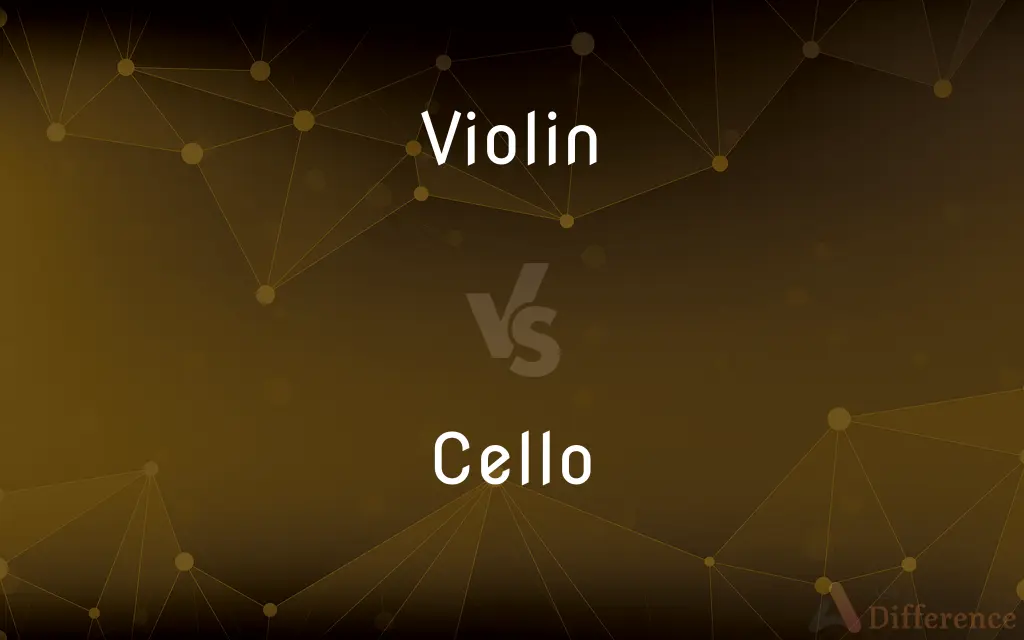Violin vs. Cello — What's the Difference?
Edited by Tayyaba Rehman — By Maham Liaqat — Updated on March 30, 2024
The violin, known for its high pitch and versatility in genres, is the smallest string instrument in its family, played under the chin. The cello, with its rich, deep tones, is larger, played sitting down, and rests on the floor.

Difference Between Violin and Cello
Table of Contents
ADVERTISEMENT
Key Differences
The violin and cello are both essential members of the string family, but they differ significantly in size, pitch, and playing position. The violin is the smallest of the string instruments, producing the highest pitch sounds. It is typically held under the chin and played standing or sitting. The cello, on the other hand, is much larger, requiring the musician to play it seated with the instrument resting on the floor, anchored by an endpin.
In terms of sound, the violin is known for its bright, sharp, and penetrating quality, making it a lead instrument in orchestras and ensembles. It is versatile, used in a wide range of musical genres from classical to folk and rock. The cello offers a rich, deep, and warm tone that can convey a wide range of emotions, from melancholy to elation. It often plays a supporting role in an ensemble but also shines as a solo instrument.
The playing technique between the two also varies. Violinists use a lighter bow and have to master playing in higher positions on the fingerboard to produce its wide range of notes. Cellists, due to the instrument's size, use a heavier bow and rely more on arm movement. Their playing involves a unique combination of finger strength and dexterity to navigate the larger fingerboard.
Another distinction lies in their roles within musical compositions. The violin often carries the melody in orchestral works, given its piercing tone that cuts through other sounds. In contrast, the cello frequently provides the harmonic foundation, supporting the melody with its deep, resonant tones. However, both instruments are capable of a wide range of expressions and can interchange roles in different musical contexts.
String tension and tuning are additional differences. The violin strings are tuned in perfect fifths (G, D, A, E), allowing for a wide range of notes in a relatively small space. The cello is also tuned in fifths (C, G, D, A), but its larger size and lower pitch range give it a powerful resonance that the violin cannot match. This makes the cello suited for both melody and harmony, enriching an ensemble's sound texture.
ADVERTISEMENT
Comparison Chart
Size and Position
Smallest string instrument, played under chin
Larger, played seated with endpin on floor
Sound
High pitch, bright, versatile
Deep, rich tones, warm
Role in Ensemble
Often leads with melody
Provides harmonic foundation, supports melody
Playing Technique
Lighter bow, high positions on fingerboard
Heavier bow, arm movement, larger fingerboard
Tuning
Tuned in perfect fifths (G, D, A, E)
Tuned in perfect fifths (C, G, D, A)
Compare with Definitions
Violin
The soprano member of the string family.
In the orchestra, the violin sections are typically positioned at the front.
Cello
Capable of both melodic and harmonic roles.
The composer wrote a piece that showcased the cello's melodic capabilities.
Violin
A stringed musical instrument of high pitch, played with a bow.
She practiced the violin every day to master the concerto.
Cello
Played seated, resting on the floor with an endpin.
The cellist adjusted her seat and the endpin before the performance.
Violin
Requires precise finger placement.
Learning the violin involves mastering finger placement for intonation.
Cello
A bass stringed instrument of the violin family, with a deep and rich tone.
The cello's solo filled the room with its warm sound.
Violin
Associated with a wide range of music genres.
The band's violinist blended classical techniques with rock music.
Cello
Essential in both solo and ensemble settings.
His cello performance was a highlight of the chamber concert.
Violin
A tool for creating both melody and harmony.
He used the violin to add a haunting melody to the soundtrack.
Cello
Known for its emotional depth and versatility.
She chose the cello for its ability to convey a wide range of emotions.
Violin
The violin, sometimes known as a fiddle, is a wooden chordophone (string instrument) in the violin family. Most violins have a hollow wooden body.
Cello
The cello ( CHEL-oh; plural celli or cellos) or violoncello ( VY-ə-lən-CHEL-oh; Italian pronunciation: [vjolonˈtʃɛllo]) is a bowed (sometimes plucked and occasionally hit) string instrument of the violin family. Its four strings are usually tuned in perfect fifths: from low to high, C2, G2, D3 and A3.
Violin
A stringed instrument played with a bow, having four strings tuned at intervals of a fifth, an unfretted fingerboard, and a shallower body than the viol and capable of great flexibility in range, tone, and dynamics.
Cello
A bass instrument of the violin family, held upright on the floor between the legs of the seated player.
Violin
A small unfretted stringed instrument with four strings tuned (lowest to highest) G-D-A-E, usually held against the chin and played with a bow.
When I play it like this, it's a fiddle; when I play it like this, it's a violin.
Cello
A four-stringed musical instrument of the violin family, pitched lower than the viola but higher than the double bass.
Violin
Any instrument of the violin family, always inclusive of violins, violas, and cellos and sometimes further including the double bass.
The string quartet, one of the most popular groupings in chamber music, is composed entirely of violins: two violins proper, one viola, and one cello.
Cello
A large unfretted stringed instrument of the violin family with four strings tuned (lowest to highest) C-G-D-A and an endpin to support its weight, usually played with a bow.
Violin
The position of a violinist in an orchestra or group.
The first violin often plays the lead melody lines in a string quartet.
Cello
Cellophane
Violin
(ambitransitive) To play on, or as if on, a violin.
Cello
A contraction for Violoncello.
Violin
A small instrument with four strings, played with a bow; a fiddle.
Cello
A large stringed instrument; seated player holds it upright while playing
Violin
Bowed stringed instrument that is the highest member of the violin family; this instrument has four strings and a hollow body and an unfretted fingerboard and is played with a bow
Common Curiosities
Why do violins and cellos have different roles in an orchestra?
Due to their differing sound ranges and tones, violins often carry melodies with their bright, piercing sounds, while cellos provide a harmonic foundation with their rich, deep tones.
Which is more difficult to learn, the violin or the cello?
Difficulty is subjective and depends on the individual. However, each instrument presents unique challenges, such as the violin's high positions and the cello's arm movements.
Are the strings on a violin and a cello the same?
Both instruments have strings tuned in perfect fifths, but they differ in pitch and thickness, reflecting their distinct sound ranges.
Can cellos play melodies usually played by violins?
Cellos can play violin melodies, but the sound will be in a lower octave, offering a different emotional depth due to the cello's rich tone.
What makes a cello's sound warm and deep?
The cello's size and string thickness contribute to its ability to produce warm, deep tones that resonate richly across its range.
What is the primary difference between a violin and a cello?
The primary difference lies in their size, pitch, and playing position: the violin is smaller and played under the chin, producing high-pitched sounds; the cello is larger, played seated, and produces deeper tones.
Do violins and cellos use the same music notation?
Yes, both instruments read standard music notation, but they play in different clefs primarily—violin in treble clef and cello in bass and tenor clefs.
How do the bow techniques differ between the violin and cello?
Violin bowing requires lighter pressure and often faster movement, while cello bowing involves greater arm movement and heavier pressure for its larger strings.
How does the size of a violin compare to a cello?
A violin is significantly smaller than a cello, making it more portable and played under the chin, while the cello requires seating and rests on the floor.
Can violinists easily switch to playing the cello?
While violinists can learn to play the cello, the transition requires adapting to the cello's larger size, different playing position, and unique bowing technique.
Is it common for composers to write concertos for both violin and cello?
Yes, many composers write concertos for both instruments, highlighting their unique qualities and capabilities in solo performances with an orchestra.
Share Your Discovery

Previous Comparison
Citronellol vs. Citral
Next Comparison
Oil vs. GasAuthor Spotlight
Written by
Maham LiaqatEdited by
Tayyaba RehmanTayyaba Rehman is a distinguished writer, currently serving as a primary contributor to askdifference.com. As a researcher in semantics and etymology, Tayyaba's passion for the complexity of languages and their distinctions has found a perfect home on the platform. Tayyaba delves into the intricacies of language, distinguishing between commonly confused words and phrases, thereby providing clarity for readers worldwide.














































